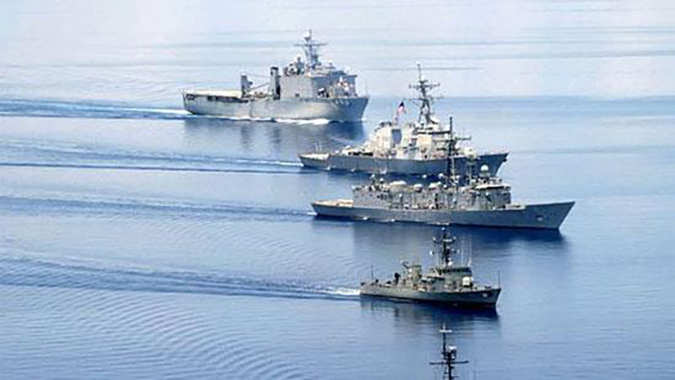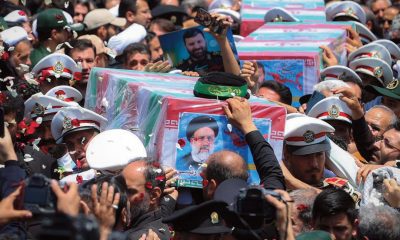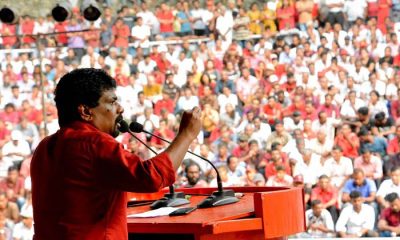Features
Sri Lanka sails into murky waters in the Red Sea

By Uditha Devapriya
Speaking at an awards ceremony on Wednesday, January 3, President Ranil Wickremesinghe announced that the government would be deploying a Navy vessel to the Red Sea. Wickremesinghe pointed out that the disruption of shipping lanes in the region would lead to increased freight charges and cargo costs, increasing import prices in the country. Arguing that this was not in Sri Lanka’s interest, he declared that the government would do what it could to contribute to stability in the region.
The announcement came as a surprise to many, not least since the President revealed it only towards the tail-end of his speech. Soon after, the government launched a feasibility study for the proposal. The President had earlier admitted that deploying a vessel would cost the government Rs 250 million every fortnight, while a Navy spokesman stated that the Red Sea operation required clear “logistics supplies” and “a robust weapon outfit.” Meanwhile, on social media and in the press, commentators and analysts weighed in on the proposal, many expressing scepticism at and condemning the move.
The Sri Lanka Navy has since confirmed that it will be despatching a number of vessels to the region. While no date has been finalised yet, the Navy has stated that the deployment will be in support of Operation Prosperity Guardian, the United States led initiative combating Houthi rebels in the Red Sea. The rebels have vowed not to back down until Israel ends its attacks on Palestine. Since December, they have planned and carried out a series of drone and missile strikes which have forced cargo ships to reroute. In response, several countries, including India, have deployed vessels to the region.
Sri Lanka is the latest country to join these efforts, but its entry seems to have left more questions than answers. For one thing, the Red Sea operation marks the first major military confrontation between the US and the Houthi rebels. This has several crucial geopolitical implications.
On the one hand, the US and its allies have justified their intervention on the grounds of protecting international trade and shipping lines, while the Houthis have justified their attacks as a show of solidarity with Palestine and Gaza. On the other, the rebels are allegedly backed by Iran, which has so far belittled or ignored US warnings, and has gone so far as to deploy a warship in response to escalating tensions.
Complicating matters further, US allies themselves seem less than forthcoming about their involvement. When Washington launched Operation Prosperity Guardian in December, the Pentagon announced a united campaign of several countries, many from Europe. Yet apart from a few like the UK, most of them have kept their participation under wraps. The more forthcoming among them have made relatively modest contributions, while key allies such as Germany have been ambivalent about the extent of their intervention.
On the face of it, Europe’s indecisiveness has left an opening for US allies in other regions to assert their strength in the Red Sea operation. India, for instance, has despatched escorts, including frigates and destroyers, for Indian container ships.
The United States has invited Delhi to join its coalition, the Combined Maritime Forces, expanding its reach in the Red Sea as well as in adjacent regions. Yet while India has been willing to commission vessels to the Red Sea, it has preferred to maintain its own presence rather than joining a coalition. As of now, tellingly, no Asian country apart from Bahrain – the sole Gulf country to join – has deployed vessels for the operation; Singapore and Seychelles have agreed to take part, but only to contribute to information sharing.
Sri Lanka’s willingness to join with US forces is hence perplexing. Ostensibly, it is filling a gap no other Asian country has: in December, it became the 39th country to join the Combined Maritime Forces partnership. While details of the vessels that will be despatched to the Red Sea have yet to be confirmed, reports indicate they will be stationed outside the immediate Houthi weapons range, given the near absence of air defence and counter-missile systems in Sri Lankan Offshore Patrol Vessels (OPVs). When these vessels enter the Red Sea, they will be placed under the command of US Task Force 153.
Yet, however perplexing these developments may be, they are hardly unpredictable. The Sri Lankan and the US Navies have been engaging and cooperating with each other for a fairly long time. Last year, for instance, they embarked on a series of training sessions to prepare for disaster relief and “maintain a free and open Indo-Pacific.” These exercises and sessions will be conducted this year as well.
The US Navy has also handed over ships and coastguard cutters to the Sri Lankan Navy. In fact, two of the three ships which have been proposed for the Red Sea operation, SLNS Gajabahu and SLNS Vijayabahu, were gifted by the US in 2018 and 2021 respectively. Given these engagements, the Sri Lankan Navy’s willingness to deploy ships to the Red Sea under the US Fleet’s command is not entirely surprising.
There are arguments for and against the proposal on both the domestic and foreign policy front. On the domestic front, perhaps the biggest concern is cost. The operation is expected to burn up LKR 250 million or USD 777,000 every two weeks. The government has justified the expense on the basis that securing the Red Sea would help stabilise import prices. On the face of it, this is true. Marine insurance rates have more than tripled since the rebels began their campaign in the Red Sea, while at least one major shipping line has diverted to the longer alternative route around the Cape of Good Hope.
But Opposition lawmakers, critics of the government, and ordinary citizens have denounced the proposal on the grounds that it brings no immediate benefit to Sri Lanka. The Leader of the Opposition Sajith Premadasa, for instance, questioned the need for such a campaign at a time when people were reeling from grinding austerity, including an unpopular Value-Added Tax which has led to massive price hikes nearly everywhere, and on every item.
Predictably, the move has also been condemned as hypocritical: while forcing Sri Lankans to practice economies at home, the government is doing the exact opposite abroad, and what’s worse, as the country’s leading political and foreign policy commentator Dr Dayan Jayatilleka observes, in a conflict that is “not our fight.”
According to political researcher and archivist Uthpala Wijesuriya, however, the problem hasn’t just to do with cost, but also with capability. While there has been no shortage of supporters of the proposal who confidently point at the Sri Lankan Navy’s past successes, including its operations against illegal drug peddling in the Arabian Sea and its supposedly untarnished historical record, the Navy relies almost exclusively on vessels gifted by foreign governments which have the latest capabilities. “The question in that sense isn’t whether we have money for these kinds of operations, but whether we have the capabilities we need and if not, who is going to give them to us,” Wijesuriya argues.
This is a valid concern. On the other hand, though, former Chief Hydrographer of the Sri Lankan Navy Rear Admiral Y. N. Jayarathna (Retd.) sees the proposal as a massive investment opportunity for the country’s military. He estimates that Sri Lanka’s OPVs require equipment like thermal cameras and stabilised platforms, and argues that the government’s decision could spur investments in such “operational necessities.” While conceding that the media may portray the government as a “US partner” vis-à-vis its operations in the Red Sea, he contends that it is time the Navy extends its activities to areas like the Gulf of Yemen and the Arabian Sea in partnership with other countries.
At the same time, however, international relations commentator Rathindra Kuruwita argues that there is a manpower problem in the military. “Motivation is at an all-time low in the army and the navy, because their members are feeling the impact of austerity, reduced food rations, and so on.” Against such a backdrop, Kuruwita says that no number of investments would motivate them to embark on such a risky mission in the Red Sea.
Moreover, perceptions of the Sri Lankan government joining up with US forces could make Sri Lanka vulnerable to attacks abroad, especially since the Houthis have vowed retaliation on anyone joining the US coalition. This has only been compounded by what Kuruwita views as Sri Lanka’s problematic stance on the Gaza issue.
“On the one hand, we are voting with the rest of the Global South on Palestine at the UN,” he says. “Yet on the other, we are sending our youth to Israel to meet labour shortages there after they expelled Palestinian workers.” According to Kuruwita, the Gaza issue has become particularly sensitive for Muslims in Sri Lanka and everywhere else. “The government is now acting in a way that is hurting their feelings. That could generate a backlash in the not-too-distant future.” All that, he concludes, could boomerang on the country, particularly as the Houthis have vowed to attack any ship connected to Israel, and the Sri Lankan government is about to join the US, Israel’s number one military partner, in the Red Sea.
These developments underlie the immense complexities that Sri Lanka faces in the current geopolitical context. The decision to deploy vessels to the Red Sea has turned the Sri Lankan Navy into more than just a passive bystander; it has turned it into an active participant in the tensions erupting in the region. While supporters of the decision may make grandiose claims about the Navy’s past successes, there is no doubt it has opened a can of worms in Sri Lanka, the full repercussions of which will be felt in the months to come.
A version of this article appeared in The Diplomat on January 11, 2024.
The writer is an international relations analyst, independent researcher, and freelance columnist who can be reached at udakdev1@gmail.com.
Features
The heart-friendly health minister

by Dr Gotabhya Ranasinghe
Senior Consultant Cardiologist
National Hospital Sri Lanka
When we sought a meeting with Hon Dr. Ramesh Pathirana, Minister of Health, he graciously cleared his busy schedule to accommodate us. Renowned for his attentive listening and deep understanding, Minister Pathirana is dedicated to advancing the health sector. His openness and transparency exemplify the qualities of an exemplary politician and minister.
Dr. Palitha Mahipala, the current Health Secretary, demonstrates both commendable enthusiasm and unwavering support. This combination of attributes makes him a highly compatible colleague for the esteemed Minister of Health.
Our discussion centered on a project that has been in the works for the past 30 years, one that no other minister had managed to advance.
Minister Pathirana, however, recognized the project’s significance and its potential to revolutionize care for heart patients.
The project involves the construction of a state-of-the-art facility at the premises of the National Hospital Colombo. The project’s location within the premises of the National Hospital underscores its importance and relevance to the healthcare infrastructure of the nation.
This facility will include a cardiology building and a tertiary care center, equipped with the latest technology to handle and treat all types of heart-related conditions and surgeries.
Securing funding was a major milestone for this initiative. Minister Pathirana successfully obtained approval for a $40 billion loan from the Asian Development Bank. With the funding in place, the foundation stone is scheduled to be laid in September this year, and construction will begin in January 2025.
This project guarantees a consistent and uninterrupted supply of stents and related medications for heart patients. As a result, patients will have timely access to essential medical supplies during their treatment and recovery. By securing these critical resources, the project aims to enhance patient outcomes, minimize treatment delays, and maintain the highest standards of cardiac care.
Upon its fruition, this monumental building will serve as a beacon of hope and healing, symbolizing the unwavering dedication to improving patient outcomes and fostering a healthier society.We anticipate a future marked by significant progress and positive outcomes in Sri Lanka’s cardiovascular treatment landscape within the foreseeable timeframe.
Features
A LOVING TRIBUTE TO JESUIT FR. ALOYSIUS PIERIS ON HIS 90th BIRTHDAY

by Fr. Emmanuel Fernando, OMI
Jesuit Fr. Aloysius Pieris (affectionately called Fr. Aloy) celebrated his 90th birthday on April 9, 2024 and I, as the editor of our Oblate Journal, THE MISSIONARY OBLATE had gone to press by that time. Immediately I decided to publish an article, appreciating the untiring selfless services he continues to offer for inter-Faith dialogue, the renewal of the Catholic Church, his concern for the poor and the suffering Sri Lankan masses and to me, the present writer.
It was in 1988, when I was appointed Director of the Oblate Scholastics at Ampitiya by the then Oblate Provincial Fr. Anselm Silva, that I came to know Fr. Aloy more closely. Knowing well his expertise in matters spiritual, theological, Indological and pastoral, and with the collaborative spirit of my companion-formators, our Oblate Scholastics were sent to Tulana, the Research and Encounter Centre, Kelaniya, of which he is the Founder-Director, for ‘exposure-programmes’ on matters spiritual, biblical, theological and pastoral. Some of these dimensions according to my view and that of my companion-formators, were not available at the National Seminary, Ampitiya.
Ever since that time, our Oblate formators/ accompaniers at the Oblate Scholasticate, Ampitiya , have continued to send our Oblate Scholastics to Tulana Centre for deepening their insights and convictions regarding matters needed to serve the people in today’s context. Fr. Aloy also had tried very enthusiastically with the Oblate team headed by Frs. Oswald Firth and Clement Waidyasekara to begin a Theologate, directed by the Religious Congregations in Sri Lanka, for the contextual formation/ accompaniment of their members. It should very well be a desired goal of the Leaders / Provincials of the Religious Congregations.
Besides being a formator/accompanier at the Oblate Scholasticate, I was entrusted also with the task of editing and publishing our Oblate journal, ‘The Missionary Oblate’. To maintain the quality of the journal I continue to depend on Fr. Aloy for his thought-provoking and stimulating articles on Biblical Spirituality, Biblical Theology and Ecclesiology. I am very grateful to him for his generous assistance. Of late, his writings on renewal of the Church, initiated by Pope St. John XX111 and continued by Pope Francis through the Synodal path, published in our Oblate journal, enable our readers to focus their attention also on the needed renewal in the Catholic Church in Sri Lanka. Fr. Aloy appreciated very much the Synodal path adopted by the Jesuit Pope Francis for the renewal of the Church, rooted very much on prayerful discernment. In my Religious and presbyteral life, Fr.Aloy continues to be my spiritual animator / guide and ongoing formator / acccompanier.
Fr. Aloysius Pieris, BA Hons (Lond), LPh (SHC, India), STL (PFT, Naples), PhD (SLU/VC), ThD (Tilburg), D.Ltt (KU), has been one of the eminent Asian theologians well recognized internationally and one who has lectured and held visiting chairs in many universities both in the West and in the East. Many members of Religious Congregations from Asian countries have benefited from his lectures and guidance in the East Asian Pastoral Institute (EAPI) in Manila, Philippines. He had been a Theologian consulted by the Federation of Asian Bishops’ Conferences for many years. During his professorship at the Gregorian University in Rome, he was called to be a member of a special group of advisers on other religions consulted by Pope Paul VI.
Fr. Aloy is the author of more than 30 books and well over 500 Research Papers. Some of his books and articles have been translated and published in several countries. Among those books, one can find the following: 1) The Genesis of an Asian Theology of Liberation (An Autobiographical Excursus on the Art of Theologising in Asia, 2) An Asian Theology of Liberation, 3) Providential Timeliness of Vatican 11 (a long-overdue halt to a scandalous millennium, 4) Give Vatican 11 a chance, 5) Leadership in the Church, 6) Relishing our faith in working for justice (Themes for study and discussion), 7) A Message meant mainly, not exclusively for Jesuits (Background information necessary for helping Francis renew the Church), 8) Lent in Lanka (Reflections and Resolutions, 9) Love meets wisdom (A Christian Experience of Buddhism, 10) Fire and Water 11) God’s Reign for God’s poor, 12) Our Unhiddden Agenda (How we Jesuits work, pray and form our men). He is also the Editor of two journals, Vagdevi, Journal of Religious Reflection and Dialogue, New Series.
Fr. Aloy has a BA in Pali and Sanskrit from the University of London and a Ph.D in Buddhist Philosophy from the University of Sri Lankan, Vidyodaya Campus. On Nov. 23, 2019, he was awarded the prestigious honorary Doctorate of Literature (D.Litt) by the Chancellor of the University of Kelaniya, the Most Venerable Welamitiyawe Dharmakirthi Sri Kusala Dhamma Thera.
Fr. Aloy continues to be a promoter of Gospel values and virtues. Justice as a constitutive dimension of love and social concern for the downtrodden masses are very much noted in his life and work. He had very much appreciated the commitment of the late Fr. Joseph (Joe) Fernando, the National Director of the Social and Economic Centre (SEDEC) for the poor.
In Sri Lanka, a few religious Congregations – the Good Shepherd Sisters, the Christian Brothers, the Marist Brothers and the Oblates – have invited him to animate their members especially during their Provincial Congresses, Chapters and International Conferences. The mainline Christian Churches also have sought his advice and followed his seminars. I, for one, regret very much, that the Sri Lankan authorities of the Catholic Church –today’s Hierarchy—- have not sought Fr.
Aloy’s expertise for the renewal of the Catholic Church in Sri Lanka and thus have not benefited from the immense store of wisdom and insight that he can offer to our local Church while the Sri Lankan bishops who governed the Catholic church in the immediate aftermath of the Second Vatican Council (Edmund Fernando OMI, Anthony de Saram, Leo Nanayakkara OSB, Frank Marcus Fernando, Paul Perera,) visited him and consulted him on many matters. Among the Tamil Bishops, Bishop Rayappu Joseph was keeping close contact with him and Bishop J. Deogupillai hosted him and his team visiting him after the horrible Black July massacre of Tamils.
Features
A fairy tale, success or debacle

Sri Lanka-Singapore Free Trade Agreement
By Gomi Senadhira
senadhiragomi@gmail.com
“You might tell fairy tales, but the progress of a country cannot be achieved through such narratives. A country cannot be developed by making false promises. The country moved backward because of the electoral promises made by political parties throughout time. We have witnessed that the ultimate result of this is the country becoming bankrupt. Unfortunately, many segments of the population have not come to realize this yet.” – President Ranil Wickremesinghe, 2024 Budget speech
Any Sri Lankan would agree with the above words of President Wickremesinghe on the false promises our politicians and officials make and the fairy tales they narrate which bankrupted this country. So, to understand this, let’s look at one such fairy tale with lots of false promises; Ranil Wickremesinghe’s greatest achievement in the area of international trade and investment promotion during the Yahapalana period, Sri Lanka-Singapore Free Trade Agreement (SLSFTA).
It is appropriate and timely to do it now as Finance Minister Wickremesinghe has just presented to parliament a bill on the National Policy on Economic Transformation which includes the establishment of an Office for International Trade and the Sri Lanka Institute of Economics and International Trade.
Was SLSFTA a “Cleverly negotiated Free Trade Agreement” as stated by the (former) Minister of Development Strategies and International Trade Malik Samarawickrama during the Parliamentary Debate on the SLSFTA in July 2018, or a colossal blunder covered up with lies, false promises, and fairy tales? After SLSFTA was signed there were a number of fairy tales published on this agreement by the Ministry of Development Strategies and International, Institute of Policy Studies, and others.
However, for this article, I would like to limit my comments to the speech by Minister Samarawickrama during the Parliamentary Debate, and the two most important areas in the agreement which were covered up with lies, fairy tales, and false promises, namely: revenue loss for Sri Lanka and Investment from Singapore. On the other important area, “Waste products dumping” I do not want to comment here as I have written extensively on the issue.
1. The revenue loss
During the Parliamentary Debate in July 2018, Minister Samarawickrama stated “…. let me reiterate that this FTA with Singapore has been very cleverly negotiated by us…. The liberalisation programme under this FTA has been carefully designed to have the least impact on domestic industry and revenue collection. We have included all revenue sensitive items in the negative list of items which will not be subject to removal of tariff. Therefore, 97.8% revenue from Customs duty is protected. Our tariff liberalisation will take place over a period of 12-15 years! In fact, the revenue earned through tariffs on goods imported from Singapore last year was Rs. 35 billion.
The revenue loss for over the next 15 years due to the FTA is only Rs. 733 million– which when annualised, on average, is just Rs. 51 million. That is just 0.14% per year! So anyone who claims the Singapore FTA causes revenue loss to the Government cannot do basic arithmetic! Mr. Speaker, in conclusion, I call on my fellow members of this House – don’t mislead the public with baseless criticism that is not grounded in facts. Don’t look at petty politics and use these issues for your own political survival.”
I was surprised to read the minister’s speech because an article published in January 2018 in “The Straits Times“, based on information released by the Singaporean Negotiators stated, “…. With the FTA, tariff savings for Singapore exports are estimated to hit $10 million annually“.
As the annual tariff savings (that is the revenue loss for Sri Lanka) calculated by the Singaporean Negotiators, Singaporean $ 10 million (Sri Lankan rupees 1,200 million in 2018) was way above the rupees’ 733 million revenue loss for 15 years estimated by the Sri Lankan negotiators, it was clear to any observer that one of the parties to the agreement had not done the basic arithmetic!
Six years later, according to a report published by “The Morning” newspaper, speaking at the Committee on Public Finance (COPF) on 7th May 2024, Mr Samarawickrama’s chief trade negotiator K.J. Weerasinghehad had admitted “…. that forecasted revenue loss for the Government of Sri Lanka through the Singapore FTA is Rs. 450 million in 2023 and Rs. 1.3 billion in 2024.”
If these numbers are correct, as tariff liberalisation under the SLSFTA has just started, we will pass Rs 2 billion very soon. Then, the question is how Sri Lanka’s trade negotiators made such a colossal blunder. Didn’t they do their basic arithmetic? If they didn’t know how to do basic arithmetic they should have at least done their basic readings. For example, the headline of the article published in The Straits Times in January 2018 was “Singapore, Sri Lanka sign FTA, annual savings of $10m expected”.
Anyway, as Sri Lanka’s chief negotiator reiterated at the COPF meeting that “…. since 99% of the tariffs in Singapore have zero rates of duty, Sri Lanka has agreed on 80% tariff liberalisation over a period of 15 years while expecting Singapore investments to address the imbalance in trade,” let’s turn towards investment.
Investment from Singapore
In July 2018, speaking during the Parliamentary Debate on the FTA this is what Minister Malik Samarawickrama stated on investment from Singapore, “Already, thanks to this FTA, in just the past two-and-a-half months since the agreement came into effect we have received a proposal from Singapore for investment amounting to $ 14.8 billion in an oil refinery for export of petroleum products. In addition, we have proposals for a steel manufacturing plant for exports ($ 1 billion investment), flour milling plant ($ 50 million), sugar refinery ($ 200 million). This adds up to more than $ 16.05 billion in the pipeline on these projects alone.
And all of these projects will create thousands of more jobs for our people. In principle approval has already been granted by the BOI and the investors are awaiting the release of land the environmental approvals to commence the project.
I request the Opposition and those with vested interests to change their narrow-minded thinking and join us to develop our country. We must always look at what is best for the whole community, not just the few who may oppose. We owe it to our people to courageously take decisions that will change their lives for the better.”
According to the media report I quoted earlier, speaking at the Committee on Public Finance (COPF) Chief Negotiator Weerasinghe has admitted that Sri Lanka was not happy with overall Singapore investments that have come in the past few years in return for the trade liberalisation under the Singapore-Sri Lanka Free Trade Agreement. He has added that between 2021 and 2023 the total investment from Singapore had been around $162 million!
What happened to those projects worth $16 billion negotiated, thanks to the SLSFTA, in just the two-and-a-half months after the agreement came into effect and approved by the BOI? I do not know about the steel manufacturing plant for exports ($ 1 billion investment), flour milling plant ($ 50 million) and sugar refinery ($ 200 million).
However, story of the multibillion-dollar investment in the Petroleum Refinery unfolded in a manner that would qualify it as the best fairy tale with false promises presented by our politicians and the officials, prior to 2019 elections.
Though many Sri Lankans got to know, through the media which repeatedly highlighted a plethora of issues surrounding the project and the questionable credentials of the Singaporean investor, the construction work on the Mirrijiwela Oil Refinery along with the cement factory began on the24th of March 2019 with a bang and Minister Ranil Wickremesinghe and his ministers along with the foreign and local dignitaries laid the foundation stones.
That was few months before the 2019 Presidential elections. Inaugurating the construction work Prime Minister Ranil Wickremesinghe said the projects will create thousands of job opportunities in the area and surrounding districts.
The oil refinery, which was to be built over 200 acres of land, with the capacity to refine 200,000 barrels of crude oil per day, was to generate US$7 billion of exports and create 1,500 direct and 3,000 indirect jobs. The construction of the refinery was to be completed in 44 months. Four years later, in August 2023 the Cabinet of Ministers approved the proposal presented by President Ranil Wickremesinghe to cancel the agreement with the investors of the refinery as the project has not been implemented! Can they explain to the country how much money was wasted to produce that fairy tale?
It is obvious that the President, ministers, and officials had made huge blunders and had deliberately misled the public and the parliament on the revenue loss and potential investment from SLSFTA with fairy tales and false promises.
As the president himself said, a country cannot be developed by making false promises or with fairy tales and these false promises and fairy tales had bankrupted the country. “Unfortunately, many segments of the population have not come to realize this yet”.
(The writer, a specialist and an activist on trade and development issues . )

























